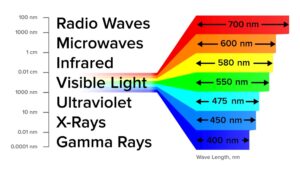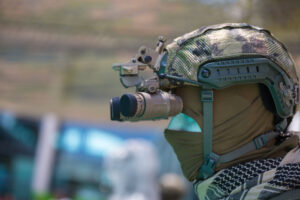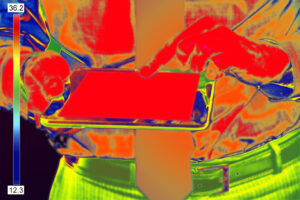Night Vision Devices sound like something straight out of science fiction or a James Bond movie. We watch as Bond slips out of the ocean under the night sky. He strips off his wetsuit and emerges in his unwrinkled tuxedo. To get to his destination he also dons special eyewear that allows him to see his way through the jungle in the dark.
That unwrinkled tux is science fiction. However, his night vision goggles are a reality. In fact, soldiers have been using equipment to see in the dark since the 1930s. Thus, ER Precision Optics thought you might like to know a little more about the fascinating technology behind night vision: the lenses and the light.
Night Vision Devices: Lenses and Light That Open Up the Mysteries of the Night

Night Vision Has Long Been a Human Dream. In the 21st Century, Technology is Making That Dream Come True.
Experts have verified that In the 1930s, German tanks and infantrymen utilized bulky, hand-carried active infrared devices and battery back-packs. These devices were “called Nachtjägers (night hunters).”
The historical experts add, “These devices were almost as big as a dinner plate.” They required the soldier operating them to carry a huge battery pack on his back.
“They were active infrared devices that were used to brighten up whatever the soldier was looking in the dark.” In that day and age, one soldier carried the device, but another would have to shoot at the enemy.
Night vision devices have come a long way since then. Now, let’s take a look at how today’s technology works. Did you know we now have night vision eyewear that can permit you to see a person more than 200 yards away?
Two Key Ways to See in the Dark
To begin, ER Precision Optics wants you to know there are two kinds of night vision devices.
1. The first kind works “…on the temperature difference between the object and the surrounding environment.”
We call this type of night vision Forward-Looking Infrared (FLIR). And you probably recognize that term from a previous blog all about it. The military installs FLIR on combat aircraft.
Meet The Other Type of Night Vision Device

Thermal Night Vision Devices Reveal Infrared Light, Invisible to the Naked Eye.
Now, another type of night vision device works off the amplification of light. Even on quite a dark night, you will notice bits of light.
2. Thus, the second kind of device works off the small amount of light found in the environment. Logically, the technology requires the presence of some degree of light. Night vision goggles fit into this category of device.
What you see through this device is the result of image intensification or image enhancement. Yes, it looks green, and there is a reason. Read on, to discover what it is.
Night Vision Through Image intensification
Let’s break down the meaning behind image intensification. It is also termed image enhancement and that is the electronic, green-colored vision you see.
Four Steps to Image Intensification In Your Night Vision Devices

Night Vision Devices Have Become More Common and Recognizable as Vital Equipment For Soldiers Who Defy the Dark.
Inside your Image Intensification Goggles, 4 Steps Help You See Like a Super Night Human
- The First Step–Photons Floating in Low Light: Tiny particles of light, named photons, float into your image-enhancing goggles. Your device gathers these photons from sources like the moon, stars, and lights in your environment.
- A Photonic Change in Behavior: Secondly, “The goggles change the way the light photons behave…” The goggles transform photons into electrons.” And then back into photons. This process actually brightens or intensifies, the light. To phrase the process more technically, tiny bits of ambient light travels through your lens. Then, it hits a photocathode. “This cathode is driven by a very high energy charge. This charged energy light then speeds across the vacuum, which is situated inside the intensifier.” Now, proceed to step three, below.
The Last Two Steps to Seeing in the (Almost) Darkness
3. Filtering the Light: The third step is the use of a green filter. This makes the intensified light much easier for you to see details.
“The intensifier occurs where it comes in contact with the phosphor screen and produces a focused image. This image further becomes magnified by the eyepiece.” And yes, it is green.
4. Humanizing the vision: The upgraded photons enter your eyes and the formerly low-light scene looks 1000 times brighter.
To put it another way, keep in mind, your goggles have precision honed lenses. “The goggles capture this light using an image intensifier and electronic means. This light is further intensified thousands of times in order to create an image. This image is then displayed on to a phosphor display.”
The Drawback to Image Intensification technology
The only drawback in this type of night vision is that it requires light, at least a little “ambient” light. “This technology can’t make something out of nothing.” No matter what you might believe from television shows and movies, image intensification night vision devices do not work in absolute darkness.
Thermal Imaging: Technology for Total Darkness
If you need to see in total darkness your night vision device must have thermal imaging. Put simply, this powerful technology can transform invisible heat into a visible picture for us.
Experts say, “Unlike image intensification, thermal imaging technology can work in total darkness — as long as something is giving off heat.”
A Special Level of Seeing in the Dark, Even in Color Display

Thermal Vision Sees Heat Instead Of Light.
Although many of us are unaware of it, you might recall from science class that light and radiation have a place on the electromagnetic spectrum. The rule of this spectrum is “The shorter the wavelength, the lower the radiation is on the spectrum. The wider the wavelength, the higher.”
Why do we care? We care because our human eyes see only a small part of the electromagnetic spectrum, the visible light. Night vision technology brings us the power to see infrared radiation (IR). And IR is totally invisible to us without technological enhancement.
Infrared radiation is “sees” heat. More heat equals more infrared radiation. Thus, some thermal night vision devices show off differing levels of heat with a brilliant display. Warm objects show up in reds and orange. colors. Colder objects reflect purple, blue, and green.
Naturally, ER Precision Optics would feel remiss if we did not mention that all of this night vision technology, whether thermal or image enhancement begins with precise lenses.
To make another Bond comparison, even if it’s “shaken, not stirred,” you cannot make a Bond martini without the proper martini glass. Quality lenses are essential.


